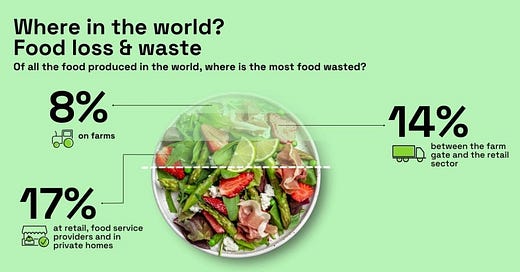Unpacking the Socioeconomic Impact of Food Waste
As we implement sustainability into our lives, it is crucial to comprehend the ramifications of food waste and the urgency with which we need to push to transform the global food system.
By Architha Sundarrajan
Searching for the expiry date on products I've purchased at the grocery has been ingrained in me since an early age. All of the harrowing tales about how I could become really sick if I ate something expired were enough to convince me to keep to this habit. But the economics student in me wonders what the social cost of these untouched, expired products is. Isn't it not only expensive but also detrimental to the environment to dump so many goods on a regular basis? With sustainability as the buzzword of the day, it is important to discuss how overproduction and waste in the food industry have far more serious consequences than anyone could possibly comprehend.
The State of Food and Agriculture 2019, defines food waste as ‘the decrease in the quantity or quality of food resulting from decisions and actions by retailers, food service providers and consumers.’ In fact, one of the 17 Sustainable Development Goals (SDG Target 12.3) established by the UN includes a target for reducing food loss and waste. By adopting a Target-Measure-Act strategy to reduce food loss and waste, it urges the world to cut these issues in half by 2030.
Roughly 14 percent of the world's food supply, worth $400 billion, is lost each year between harvest and the retail market (FAO 2019). According to UNEP (2021), food waste occurs at the retail and consumer levels at a rate of approximately 17%. According to a report published in the Corporate Social Responsibility (CSR) journal, ''Indian's waste as much food as the whole of United Kingdom consumes.'' The United Nations Development Programme estimates that India wastes up to 40% of its food production and that 21 million tonnes of wheat is wasted here every year. The amount of food that is lost and wasted annually, according to FAO estimates, could feed 1.26 billion hungry people.
According to Liz Goodwin of the World Resources Institute, “Food loss and waste is a serious issue. It presents a global challenge. An estimated 32 percent of all food produced in the world is lost or wasted from farm to fork. This huge level of inefficiency has economic, social, and environmental impacts. Food loss and waste causes about $940 billion per year in economic losses – to give you a figure that’s easier to understand, food waste costs the average family in the US around $1500 a year or the average family in the UK around £720 per year.”
According to estimates from the non-profit organisation ReFED in the US, as of 2021, consumers in the US throw away more goods overall than all US retailers combined. About 48% of surplus food produced by private US households is wasted, translating to 44 million tons of food being disposed of in landfills from US homes out of 241 million. Save the Food estimates that this could result in a $1,500 annual financial loss for a family of four on average.
Landfills of food waste are a major source of methane gas, which also contributes to climate change. According to the FAO, Food loss and waste (FLW) also account for 8-10 percent of global greenhouse gas emissions (GHGs), contributing to an unstable climate and extreme weather events such as droughts and flooding. These changes negatively impact crop yields, potentially reduce the nutritional quality of crops and cause supply chain disruptions.
Serious steps have been taken by many countries to address this issue. France, for example, has led the way in introducing policies to address food waste. It was the first nation to enact legislation prohibiting supermarkets from discarding unsold food in 2016; it must be given to charitable organisations or used as animal feed. In the meantime, a pay-as-you-throw system for household waste—including food waste—has been put in place in South Korea. In order to encourage them to reduce waste, residents are charged according to the quantity of food waste they generate. Additionally, the nation has a food waste recycling program that produces animal feed and compost out of organic waste. With programs like the creation of a National Food Loss and Waste Reduction Strategy by NITI Aayog, which provides detailed guidelines for reducing waste throughout the supply chain, India is actively working to reduce food waste.
In the 2023 report by Champions 12.3, made to evaluate the progress of SDG Target 12.3, was made public earlier in September, it was stated that even though we are halfway there, governments and businesses are moving more slowly than is necessary to achieve SDG 12.3 globally when compared to their road map. It was also noted that businesses are typically acting more quickly than governments to address food loss and waste. This demonstrates that there is still much work to be done and that governments must act now to ensure a better future.
Reducing food loss and waste can improve water resource management and land use, both of which have a positive impact on livelihoods and climate change. It also has extensive economic benefits, such as cost savings, optimal food supply chain management, and effective resource utilisation. By making the best use of available resources to meet the nutritional needs of our growing population, it will also aid in addressing global challenges related to food security. In conclusion, reducing food waste becomes strategically necessary to promote economic stability and ensure the responsible management of scarce resources in a world where demands for food security and environmental sustainability are rapidly increasing.






Quite intriguing article! Looking forward to more such articles..
Wonderful Archita! Very informative article after a thorough research! Keep it up!